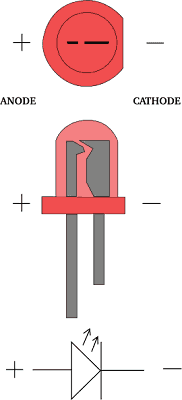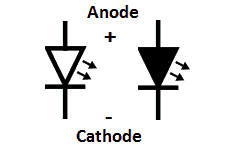Light Emitting Diodes, more frequently known as LEDs, are semiconductor devices that convert electricity into light. It was hard to find a gadget or other device that doesn’t use LEDs. They are cheap, they are simple to use, and they are small. LEDs can emit different light colors depending on other chemical compound material in a semiconductor.

LED symbol
One and universal LED symbol is as standard diodes but with a couple of arrows indicating that it emits light:
There can be few differences between different standards – some require an unfilled diode symbol, others require filling. You can also find LEDs or other semiconductors that have a circle around them. Probably simple unfilled and without circle version is the best choice as it requires less ink and time to waste in drawing it.
Recognizing LED pins
It is easy with standard LEDs – they have a unique shape that allows detecting pins easily.

As you can see, the cathode side has a flat cut on fiberglass. The cathode pin is shorter than the anode, but don’t rely on it- primarily if the diode is already used somewhere. But this is with standard through-hole diodes. We know that there are other types – so be sure to check pins in a datasheet or test before soldering.
Selecting a resistor for the LED
First of all – don’t drive any LED without a resistor. The resistor is needed to limit the electrical current that flows through the LED. Without it, the diode will fry – especially in higher voltages. So always keep in mind the general rule – don’t drive semiconductor without a resistor. So what resistor do you need?
For indicating purposes, there is no big deal. Usually, a 0,5k or 1k resistor in series works just perfectly for standard voltages like 5V. But what if you want to sure and drive LED optimally with any voltage… You have to do some math – nothing more than Ohm’s law. If you look at the diodes datasheet, you will find that LED needs about 10 to 20mA of current, and it has a forward voltage drop of about 1,8V. To be more specific, the voltage drop depends on the wavelength emitted. Starting from Infrared voltage drop is about 1,5V while Ultra Blue reaches 3,8V drop. And current usually depends on LED power can be hundreds of milliamps or even several amps.

Okay, let us take a standard 5mm diode (20mA and 2V) and find the proper resistor if the supply voltage is 5V. If you look in any LED datasheet, you will see the following chart indicating the relation between LEDs’ forward current and forward voltage drop. These are the main characteristics in determining the LED voltage drop under the desired current. And as you see, the brightness of the LED directly depends on the current flowing through it.
Let’s find a working point keeping in mind not to exceed the maximum allowed current, which is 20mA in our case, and find a forward voltage drop equal to 20. So now, let’s calculate the resistor value.
It’s easy. First of all, subtract LED drop voltage from supply voltage:
Vr = Vs – Vd = 5 – 2 = 3V.
This means that 3V has to drop on the resistor. Now by using simple Ohms law, we can easily calculate resistor value:
R = U / I = 3V / 20mA = 150 ohms.
Lets put these calculations in a straightforward formula:
Here you can see that VS – stands for Supply voltage; VD – Diode forward voltage drop; ID – forward diode current;
This way, we can calculate resistor value under any circumstances. Of course, be sure not to drive LED at maximum current for a long time. Large currents shorten its life. Leave some reserve by selecting a more significant resistor value. You can always double resistor values up to standard 330 Ohm. Your eye won’t see the difference in intensity change, but this will be much healthier to LED. More about LEDs here.




